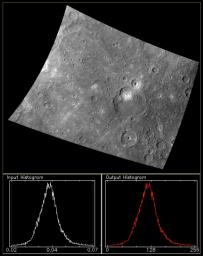
|
256 Shades of Grey
- Click the image above for a larger view
- Full-Res JPEG (1542 x 1941) (282.2 kB)
- Full-Res TIFF (1542 x 1941) (9.0 MB)
Caption:
Today's feature is the 748-nm filter image from from the October 21, 2013 color presentation. The graphs underneath the image illustrate a basic principle of image processing: the contrast stretch . A computer is typically capable of displaying a black and white ("greyscale") image as a series of pixels with 256 levels of brightness, between 0 (black) and 255 (white). Therefore, in order to be displayed, the numerical values of the image must be "stretched" to cover the range 0 to 255. In the case of a calibrated MDIS image, the image values are in physical units of reflectance -- that is, the percentage of incident light that the surface reflects. The graphs underneath the image are histograms. The x -axis is the range of pixel values that occur in the image, and the y -axis is the frequency of the values. The histogram on the lower left shows that the range of reflectance values in the image is from about 0.02 to 0.07 (or about 2% to 7% reflectance). The plot peaks at about 0.04, indicating that the most frequent pixel value is about 0.04. The plot on the lower right shows how the input pixel values have been scaled from 0 to 255 to produce the image above. Note that to display a color image (i.e., in red-green-blue), each of the three input color planes is stretched separately.
This image was acquired as a high-resolution targeted color observation. Targeted color observations are images of a small area on Mercury's surface at resolutions higher than the 1-kilometer/pixel 8-color base map. During MESSENGER's one-year primary mission, hundreds of targeted color observations were obtained. During MESSENGER's extended mission, high-resolution targeted color observations are more rare, as the 3-color base map covered Mercury's northern hemisphere with the highest-resolution color images that are possible.
Date acquired:
October 21, 2012
Image Mission Elapsed Time (MET):
259266840
Image ID:
2803280
Instrument:
Wide Angle Camera (WAC) of the Mercury Dual Imaging System (MDIS)
WAC filter:
7 (748 nanometers)
Center Latitude:
-23.00°
Center Longitude:
268.4° E
Resolution:
674 meters/pixel
Scale:
The scene is about 890 km (553 mi.) across
Incidence Angle:
45.6°
Emission Angle:
33.5°
Phase Angle:
78.7°
North is up in this image.
Background Info:
The MESSENGER spacecraft is the first ever to orbit the planet Mercury, and the spacecraft's seven scientific instruments and radio science investigation are unraveling the history and evolution of the Solar System's innermost planet. MESSENGER acquired over 150,000 images and extensive other data sets. MESSENGER is capable of continuing orbital operations until early 2015.
For information regarding the use of images, see the MESSENGER image use policy .
Cataloging Keywords:
| Name | Value | Additional Values |
|---|---|---|
| Target | Mercury | |
| System | ||
| Target Type | Planet | |
| Mission | MESSENGER | |
| Instrument Host | MESSENGER | |
| Host Type | Orbiter | |
| Instrument | Mercury Dual Imaging System (MDIS) | |
| Detector | Wide Angle Camera (WAC) | |
| Extra Keywords | Color, Map, Radio | |
| Acquisition Date | ||
| Release Date | 2013-10-23 | |
| Date in Caption | 2012-10-21 | 2013-10-21 |
| Image Credit | NASA/Johns Hopkins University Applied Physics Laboratory/Carnegie Institution of Washington | |
| Source | photojournal.jpl.nasa.gov/catalog/PIA17547 | |
| Identifier | PIA17547 | |
